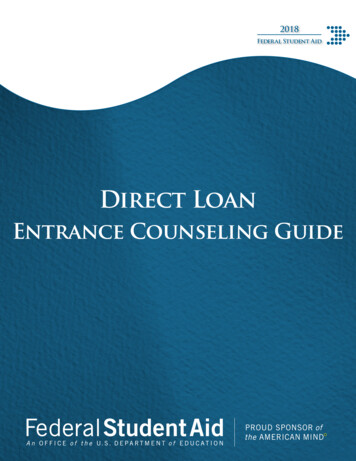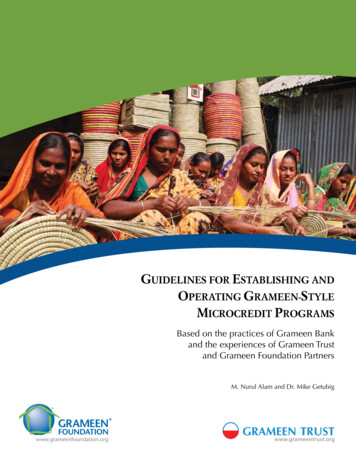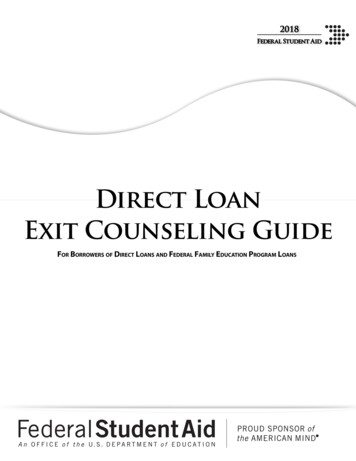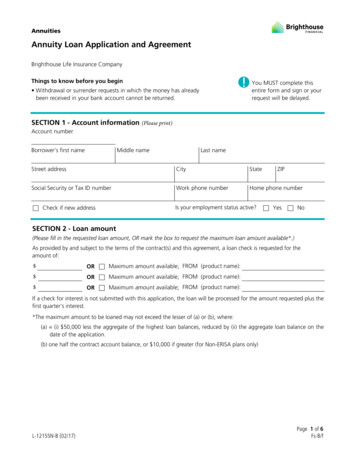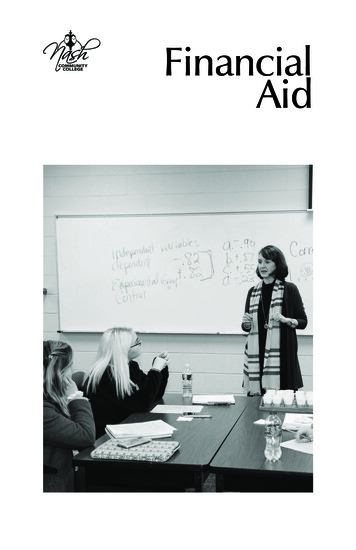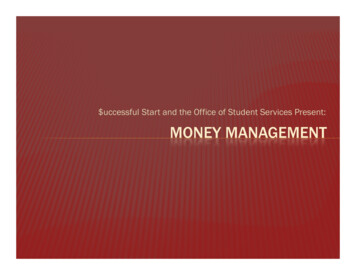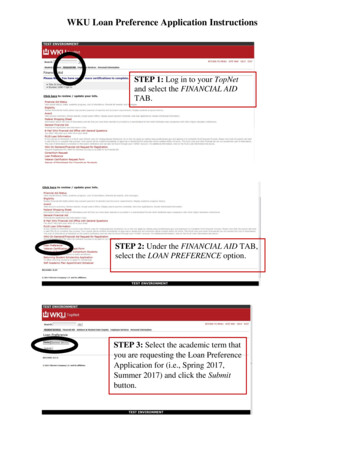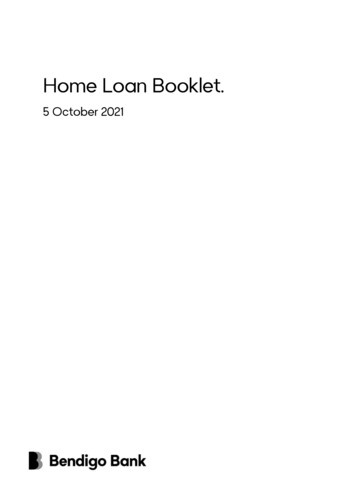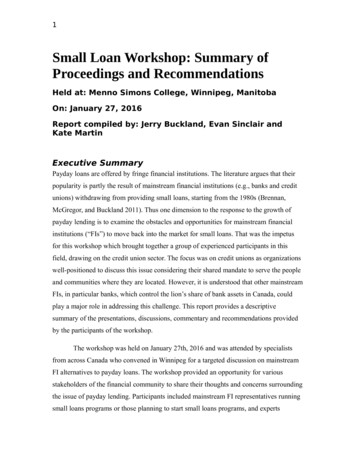
Transcription
1Small Loan Workshop: Summary ofProceedings and RecommendationsHeld at: Menno Simons College, Winnipeg, ManitobaOn: January 27, 2016Report compiled by: Jerry Buckland, Evan Sinclair andKate MartinExecutive SummaryPayday loans are offered by fringe financial institutions. The literature argues that theirpopularity is partly the result of mainstream financial institutions (e.g., banks and creditunions) withdrawing from providing small loans, starting from the 1980s (Brennan,McGregor, and Buckland 2011). Thus one dimension to the response to the growth ofpayday lending is to examine the obstacles and opportunities for mainstream financialinstitutions (“FIs”) to move back into the market for small loans. That was the impetusfor this workshop which brought together a group of experienced participants in thisfield, drawing on the credit union sector. The focus was on credit unions as organizationswell-positioned to discuss this issue considering their shared mandate to serve the peopleand communities where they are located. However, it is understood that other mainstreamFIs, in particular banks, which control the lion’s share of bank assets in Canada, couldplay a major role in addressing this challenge. This report provides a descriptivesummary of the presentations, discussions, commentary and recommendations providedby the participants of the workshop.The workshop was held on January 27th, 2016 and was attended by specialistsfrom across Canada who convened in Winnipeg for a targeted discussion on mainstreamFI alternatives to payday loans. The workshop provided an opportunity for variousstakeholders of the financial community to share their thoughts and concerns surroundingthe issue of payday lending. Participants included mainstream FI representatives runningsmall loans programs or those planning to start small loans programs, and experts
2involved in studying the sector. The FI representatives came from the credit union sector,which is particularly active in this field. However, it is understood that small loansproducts can also be offered by mainstream banks.The objective of the workshop was to identify current mainstream FI products,and obstacles and opportunities for introducing an alternative product to payday loansthat takes into consideration the long-term financial well-being of consumers in additionto their critical short-term needs. The workshop was part of the Manitoba Consumers’Experiences with Payday Loans Research Study being conducted by the Public InterestLaw Centre for this hearing.The day consisted of presentations on existing alternatives to payday loans fromcredit union specialists from across the country including, Catherine Ludgate1, TeriBuckley2, Courtney Hare3 and Kevin Morris4, followed by plenary discussions facilitatedby Maia Graham-Derham5 and Kate Martin6.The workshop began with presentations on products that are currently beingprovided in Canada, such as the Fair & Fast Loan and the Cash Crunch Loan, as well asinternationally, such Tandas and Q Cash software. These presentations provided aplatform for learning through past successes and shortcomings.The group discussion that followed identified a variety of factors perceived to beobstacles and opportunities to making such a product available. Participants highlightedmany factors to be taken into consideration, including availability of resources, provinciallegislation on payday loans, potential for community partnerships and consumerbehaviour. Despite these considerations, participants’ experiences suggested that the123456Manager of Community Investment at Vancity, located in Vancouver, and works extensively on programs aimed atfinancially empowering people living in poverty. She presented on Vancity's Fair & Fast Loan.Community Brand Manager at Connect First Credit Union, located in Calgary, and is committed to helpingAlbertans to succeed in breaking the payday loans cycle. She presented on Connect First's and Momentum's CashCrunch Loan.Public Policy Manager at Momentum, an organization based out of Calgary, and is interested in addressing theroot causes of poverty by engaging with low-income communities to promote economic development.Shepresented on Connect First's and Momentum's Cash Crunch Loan.Senior Advocacy Analyst at Credit Union Central Manitoba and has attended the workshop to share his researchon innovative alternatives to payday loans. He presented on international examples of alternatives to payday loans.Manager of the Financial Access Program at Assiniboine Credit Union that is focused on financially empoweringits members and their communities.Policy Analyst and member of the Government Relations Advocacy Team at Canadian Credit Union Associationwhere she works to advance the social and ethical performance of credit unions.
3demand for an alternative to payday loans does exist, and that such a mainstream FIproduct can be mutually advantageous to the borrower and the lender.IntroductionA one-day workshop was held to examine the potential for new and expanding small loanprograms to be offered by mainstream FIs, particularly credit unions. The workshop wassupported by CAC Manitoba Branch, Community Financial Counseling Services,Winnipeg Harvest and the Public Interest Law Centre. Specialists from the credit unionssector from across Canada joined academics and researchers to discuss obstacles andopportunities to providing small loans by mainstream FIs. Presentations providingexamples from the current environment of alternatives to payday loans were made byCatherine Ludgate, Teri Buckley, Courtney Hare, France Michaud, Kevin Morris andKate Martin. These presentations were followed by a group discussion facilitated by MaiaGraham-Derham and Kate Martin, which allowed participants to share their uniqueperspectives in considering how to effectively address this complex issue in Canada andin Manitoba.Following the workshop, a summary description of the presentations, discussionand recommendations identified by the participants was compiled into this report to befiled with the Public Utilities Board for the hearing on payday lending taking place inmid-April 2016. Elements identified during the workshop will also be used byparticipants of the workshop in their work developing an alternative product to paydayloans provided by fringe financial institutions.The MethodThe workshop was held on one day, January 27, 2016, at Menno Simons College inWinnipeg, Manitoba. The agenda was agreed to ahead of time by a coordinating subcommittee. Notes were taken by 3 individuals and then one of them was assigned the taskof pulling together a summary set of notes. These notes were then vetted by participants.This report includes these notes plus the introduction, conclusion, and recommendationswritten by the compilers of the notes.
4The IssuePayday lending is an important phenomenon across Canada and in Manitoba. Regulatoryresponses have varied across provinces. However, studies have found that regulatingpayday lending is one of two critical responses, the second being increasing the efforts ofmainstream FIs to offer comparable products (Dijkema and McKendry 2016, Buckland2012).Participants agreed that payday loans are popular. However, this comes at a costthat may be inconsistent with consumers' long-term interests, particularly repeatborrowers’ – those who become reliant on taking out many small loans in a short periodof time. This has been identified in the academic literature as a concern (Pew CharitableTrusts 2012).It was identified that payday lenders have an interest in repeat borrowing and tomaintain as large of a client base as possible. This not only restricts the ability ofborrowers to flourish financially, but communities and local economies as well, aspayday lenders continue to provide financial assistance to those who are locked into acycle of debt caused by high-cost borrowing.Taking into account existing payday lending practices, the following examples ofalternatives to payday loans represent an effort to meet the critical demands of consumerswhile also considering their long-term financial needs.Session 1: Current Alternatives to Payday LoansFair & Fast Loan VancityCatherine Ludgate presented the Fair & Fast Loan that was developed by a task forcewithin Vancity’s marketing department. Mandated by Vancity’s board of directors, thistask force identified a need for an alternative to payday loans when an internal studyrevealed that 15% of their members were using the services of payday lenders. Withapproximately 275 payday lending outlets across the province of British Columbiacharging an average annual percentage rate (APR) of 599%, Vancity began to address thisissue by asking who are payday loan users and why they use payday loans. The task forcefound that there were three main groups of users:
5 the credit challenged, people whose credit rating was damaged so that they wereunable to access small loans; the product seekers, people who are seeking small dollar loans for a short periodof time; and the convenience seekers, people who are attracted to payday loans because of theease –time needed, documents required, etc.-- in which they can be accessed.Vancity established that they could not accommodate the convenience seekers because ofsuch factors as hours of operation and a more involved application process. Thus, theydecided to focus on the credit challenged and the product seekers.Vancity’s Fair and Fast Loan is a unique alternative to a payday loan. Comparedto conventional payday loans, it is a low cost loan, offering the same interest rate that acredit card would (19% APR) for a term of up to 24 months. Loans range from 100 to 2,500 with flexible repayment terms. The Fair & Fast Loan also provides clients withthe opportunity to build up their credit by helping those who use it to build a credithistory – a feature that differs from conventional payday lending products.The approval process is designed to be accessible and efficient, allowing thewhole process to be completed in one visit that lasts approximately 60 minutes. Loanapplicants are only required to provide identification and a current pay statement. Toexpedite the approvals process, Vancity empowered frontline staff to decide whether ornot the applicant is eligible to receive the loan. Approvals are based on the applicant'spurpose for requesting a loan, their credit score, and their current employment status. Toaccess the Fair & Fast product, individuals are required to become a member of the creditunion.Vancity shared that approximately 50% of the applicants were approved duringthe first year and a half since the product was launched, which translates to providing1,750 loans to members. The average size of the loans was 1,100 and the average timeof repayment was fourteen and a half months. The total sum of loans disbursed amountedto 850,000 in what Vancity captures as impact lending (borrowers who would not have
6had access to that credit otherwise). Approximately 10% of the applicants for this loanduring this period were new members, joining the credit union specifically to access thisproduct.The introduction of the Fair & Fast product also provided the opportunity to holdaround 3,000 conversations with members about their credit. Vancity estimates that theseloans resulted in nearly 3 million in savings for customers that would have taken out acomparable loan from a payday lending agency. Further, Vancity did not experience anincrease in fraud or defaults during the first phase of the Fair and Fast Loan. Vancityindicated that this product is financially viable for the credit union.Some significant learning that has contributed to the success of the productincludes enhanced awareness of members’ perceptions of the credit union whencompared to a payday lending institution. Through closer engagement with theirmembers, Vancity discovered that the way people were being treated at the credit unionplayed a major role in determining whether they would turn to payday lenders' services ina time of need.Through the experience of providing this product, Vancity concluded they shouldact as a friend rather than a parent to people experiencing a financial emergency. Whetherthis meant improving cash checking services and making their members' money moreaccessible, or providing financial literacy and assisting with long-term strategies, Vancityfound that closer engagement with the community was a key aspect of the product’ssuccess. Vancity also sees future opportunities in increasing eligibility by balancinginclusivity and risk, enhancing accessibility and convenience, as well as building externalmarket awareness.Cash Crunch Loan Connect First & MomentumTeri Buckley from Connect First Credit Union and Courtney Hare from Momentumpartnered to present the first phase of the Cash Crunch Loan. The two organizationsbecame informal partners in 2011 based on a mutual commitment to helping those thatare under-banked and the recognition that a cross-sectoral response was necessary to
7address issues faced by those who are under-banked in Calgary. The creation of analternative to payday lending was identified as part of this response.Connect First Credit Union’s capacity to work with Momentum to design andoffer an alternative payday loan product was driven by an anonymous donation to thecredit union that protects the credit union from risk associated with this type of lending.As an organization that is dedicated to community economic development, Momentumhad already formed relationships with suitable loan candidates, and was able to referparticipants directly to Connect First Credit Union that were identified as being in need ofthe service.During the first and pilot phase of the Cash Crunch Loan, from April to August2015, applicants had to be referred by Momentum, limited screening of applicants wasdone and the product was designed as direct competition to payday loans. For Phase 1,the maximum candidates were eligible to receive was 1,500 with a 12% interest rate(APR) for a term of up to 18 months. The loan application took approximately 1.5 hoursand the cash was distributed within 24 hours. In total 56 loans were provided for a total ofapproximately 75,000 for a range of purposes, such as basic needs, general debt,housing and paying off payday loans. The size and duration of this loan is similar to theFair and Fast loan but the additional referral process adds a feature not found in theVancity product.One of the most striking outcomes of Phase 1 of the project identified by ConnectFirst Credit Union and Momentum was overcoming the participants' barriers to banking.However, this not only required a change in practice, but a change in attitude as well. Thepartnership between the organizations established a workshop for credit union employeesthat helped them better understand people’s situations and the factors that werepreventing them from accessing financial services.Consumers who approached them at critical points in their lives felt like theywere being helped rather than judged. Further, it allowed Momentum to work directlywith the participants to establish whether a loan was the best course of action, or whetherreferrals to other types of service could be provided.
8For the second phase of the project, Momentum and Connect First will focus onproviding Momentum facilitators with additional training so that they will be better ableto assess whether applicants are ready to be referred for a loan. The participant’s ability torepay will be examined more thoroughly, requiring that sixty days of banking history beprovided along with a bank statement, ensuring that no participant’s credit score is madeworse off than before. Applicants will also be required to complete a money managementcourse (offered by Momentum), demonstrate a sustainable budget, and have no preexisting loan. The product will also be open to other community partner referrals.Rather than try to compete with the convenience that payday lenders offer,Momentum and Connect First hope to direct their future efforts toward increasingcommunication between all stakeholders and forming new partnerships in the communityto provide consumers with the product that best meets their needs.Co-opme DesjardinsThe third small loan model that is the Co-opme program currently operating is offered bythe Desjardin Federation in collaboration with participating caisse populaire. This loan issimilar to the Fair and Fast loan and the Cash Crunch loan in size and duration. However,to obtain the loan, the borrower must work with a financial literacy counsellor.France Michaud presented the Co-opme program, which was launched byDesjardins in 2011 in order to promote financial education and financial inclusion andoffer new initiatives in this area. Among the Co-opme program is Desjardins solidaritybased finance initiatives. Solidarity-based finance is aimed at individuals who do notqualify for traditional financing. Desjardins works with nearly 100 community-basedorganizations, which act as the main entrance point to engaging with people who areexperiencing financial difficulty.Although payday loans are prohibited by law in Quebec, there still exist informalactors providing high-cost loans, which also offer convenience, speed, proximity andsimplicity (e.g. Insta Cheques, www.comptant.com, Rapide Cheque).In response to this trend, Desjardins introduced Mutual Assistance Funds, asolidarity-based product which offers budget counseling and, when needed, small
9interest-free loans for unexpected expenses related to essential needs; they are not meantto cover ongoing basic needs. The loans are paid directly to the service provider to whomthe debt is owed (e.g. car mechanic, dentist, etc.) rather than to the individual. AlthoughDesjardins provides the financing for these initiatives, the community organizations withwhich they partner are responsible for offering financial literacy, budgeting and loanallocation services. So far, this program has reached over 31,000 individuals.Since the program was introduced, nearly 7,000 interest free loans have beenprovided that range between 500 and 1,000 with a 2-year repayment period. Theaverage loan is 582 and the repayment rate is 84%. However, as these loans are meant toassist people in emergency situations, the organizations do their best to provide efficientservice.Currently the loans provided by the program are not registered with the creditbureau, but Desjardins hopes to change that so participants can improve their creditrating. Desjardins has recently announced that an additional 4.5 million will be investedfrom 2015-2017 to increase the program’s reach and improve their quality of services,which will require closer coordination between partners and a more standardizedapproach to loan provision and monitoring. In the past months, increased efficiency hasmade the product more attractive and more credit unions are offering it.International ExamplesKevin Morris from Credit Union Central of Manitoba presented a number of innovativealternatives to payday loans that have been developing around the globe. Q Cash is a type of software that interfaces with the core banking system of acredit union. Members are able to apply conveniently from their mobile device,online banking account or any branch location. The software pulls the bankingdata directly from the member’s file and assesses their level of risk using analgorithm that checks ten years of credit history and other associated factors.By making the entire process automated the developers have allowed the system to makethe decision and have the money deposited into the member’s account within one minute.The creator of the program, Washington State Employees Credit Union, books over 30,
10000 loans annually while maintaining a loan loss rate in the 6-8% range that allows themto generate a considerable profit. This technology is not yet available in Canada. Founded in 2014 and based out of the United Kingdom, the Churches' MutualCredit Union program was established to raise the profile of an alternative optionto payday lending. Its development also coincided with a financial crisis that gavean added sense of urgency to providing a cost-effective form of credit. They offerfair rates that are based on the current socio-economic environment. The programis very small and membership is currently restricted to clergy and ministers,licensed lay ministers, and trustees and employees of the churches. Most common in Latin America, Tandas (also known as informal rotating savingsand credit association or ROSCAS) are short-term no-interest loans arrangedamong friends or community members to assist individuals who are strugglingfinancially. They are organized in a number of ways, but normally involve a groupof well-acquainted individuals who collect money on a weekly, monthly or yearlybasis, which is then provided to one recipient in regulated intervals. The risksinvolved in the process are managed by trust and an investment of socialcollateral. There are start-ups in the UK and the US mimicking these modelsusing the Internet. Founded in Germany in 2005, Smava is an online lending service that acts as analternative to payday lending by facilitating peer-to-peer lending. Smava.de offersthe potential for borrowers to obtain cheap credit by connecting them directly toprivate investor funds. The site also acts as a loan aggregator that providescomprehensive comparisons between all the conditions and interest rates of loansbeing offered by various lenders. The Rio Grande Valley Credit Union based in Texas has developed and tested analternative payday loan product: Fast Cash Loan. Marketed as a very simplealternative to payday loans, it allows consumers to access loans that theyotherwise would not be able to. One stipulation is that the potential borrower musthave been a member of the credit union for a minimum amount of time while also
11maintaining a good credit history with them. In addition, borrowers are requiredto make a small 8 deposit into a frozen checking account that is held to pay offoutstanding debts. Another example is the Employer Sponsored Small Dollar Loan that was foundedin Toledo, Ohio. The concept requires select employer groups to partner withcredit unions to offer small loans to their employees. The outstanding fee iswithdrawn directly from the accounts into which their direct deposit checks aregoing.Peer-to-Peer LendingWith the rise of peer-to-peer lending practices, the Canadian Credit Union Associationand Filene Research Institute recently produced research outlining opportunities for creditunions to get involved in the area. Kate Martin, from the Canadian Credit UnionAssociation, shared that there are three ways credit unions can engage with peer-to-peerlending models: the first is to become an institutional investor; the second is to bring retailsales to the crowd-funding stage; and the third is simply to create a credit union owned peer-to-peer platform.For the purposes of this roundtable discussion, peer-to-peer lending platforms wereconsidered as a strategy to attract new, non-traditional members; particularly those whomay otherwise see payday lending or other fringe financial services as their only option.Research shared during the workshop showed that peer-to-peer lending platforms arealready providing an alternative for borrowers who otherwise may have used payday loanservices, high-interest credit cards or illegal loan sharks. Considering low overhead costs,peer-to-peer platforms could provide credit unions with a mechanism to provide low costlending products.
12Session 2: ObstaclesDespite the successes of some current alternatives to payday loans described in thepresentations summarized above, many obstacles remain that deter FIs from introducingsuch a product to the services they offer.The following obstacles to introducing alternative products to payday loans inManitoba and Canada were produced from a group discussion facilitated by MaiaGraham-Derham that encouraged input from all of the workshop participants.Delivery ChallengesConvenience was a significant factor identified for customers choosing payday loans. Atthe payday lender you don’t need an appointment; you simply need a loan. Mostmainstream FIs (banks and credit unions) cannot deliver that kind of impromptu service.Owing to challenges such as established approval processes designed to mitigate risk andregulatory requirements when issuing a loan, for example, these mainstream FIs have nothistorically had the infrastructure to provide fast and easy access to credit.How to deliver such a product without being seen as paternalistic was anotherfactor identified. Assistance should come first from credit unions and advice after. Animportant challenge is whether financial literacy should be provided within the creditunion or if it might be better provided by other organizations, possibly upon referral fromFIs. Furthermore, there is currently very limited financial literacy material in schoolcurriculum.Another challenge identified was delivery in rural areas, especially in moreremote First Nations communities. This can often be a significant challenge for FIs.Profitability of ProductsIn order for mainstream FIs to offer an alternative payday loan product, the product mustbe profitable for the institution. There are considerations of pricing that must be takeninto account for any product offered by FIs. Credit unions are risk averse, so risk ofdefault and non-repayment are major deterrents in their willingness to engage on thisissue.
13Design ChallengesWhen considering product design, participants indicated that first identifying the marketfor these types of loans was necessary. Payday loans serve a very wide demographic, buttwo very different main groups of payday loan users can be identified.The first is a low income group that uses the loan to finance their basic necessitiesand the second is a middle income group that uses the loan to finance a lifestyle they maynot be able to afford.The question becomes whether to design the product for middle income or lowincome? The low income demographic often possess adequate financial literacy, but maynot have the capital to deal with emergency situations that pose high financial costs,while the middle income demographic might benefit more from educational services onsaving and money management. The product design would need to take these differencesinto account.The question of how to cater to newcomers who may not have any establishedcredit and who may have different needs than other groups was also identified.Another design challenge related to which department of the financial institutionthe product should be developed. The retail or marketing department can have moreinformation about some aspects of what will make a product successful, while thecommunity investment department is likely to have more expertise in what is neededwithin the community.Lack of Reliable DataParticipants identified that it is difficult to understand the payday loans business and thecontext of their client base without access to data about the business. Participants were infavour of mandatory public disclosure of data by payday lenders, perhaps by collectionthrough the provincial regulator and published in aggregate form. Participants noted theway a market economy should work is that consumers have access to such information tomake informed and careful decisions.
14It was noted that the two biggest payday lenders currently operating in Canada areprivately owned by American companies, so that little information is available aboutthem and the market, including things such as level of profit and degree and type ofcompetition.The lack of data on payday lender consumers is also a significant challenge inunderstanding the type of product that could be developed by mainstream FIs.Working with the Credit BureauIt is difficult for credit unions to work with individuals who have bad credit ratings andnew-comers to the country who have no credit history. Although alternatives to paydayloans present an opportunity to improve their credit, it should also be considered thatwhile working with this demographic it is important to ‘do no harm’ so that credit ratingsare not made worse by offering loans to those who are unable to pay them back. Credit ismeant for empowering people to meet their economic needs so they can flourish andcontribute to the economy.Size of the MarketFIs are forced to consider the desired results of a product while trying to balance betweenmeeting the critical needs of the consumer and earning a sustainable amount of profit.The dichotomy between high-touch and low-reach or low-touch and high-reach wasmentioned numerous times in the discussion. High-touch is a safer approach to ensuringthe consumer’s needs are met, while high-reach is offers a greater opportunity for theproduct to earn a profit.Customer ServiceCulturally, payday lenders work to create an approachable and comfortable environmentas a tactic to attract customers. Payday lenders' employees are trained to make customersfeel comfortable and give them what they need when they need it. They also have asufficient margin for giving special treatment to customers that allows them discretion towave small fees or forego first-time charges when they see fit.In addition, there is also a major cultural barrier to overcome. The sense ofinformality or ‘anonymity’ that is portrayed throughout the payday loan process is
15advantageous given the often personal circumstances that lead people to require such aloan. Further, people do not always act rationally when they are in an emergency situationand the product that payday lenders offer provides a type of instant relief (with long termconsequences) with which it is difficult to compete.Although the obstacles to introdu
decided to focus on the credit challenged and the product seekers. Vancity's Fair and Fast Loan is a unique alternative to a payday loan. Compared to conventional payday loans, it is a low cost loan, offering the same interest rate that a credit card would (19% APR) for a term of up to 24 months. Loans range from 100 to

